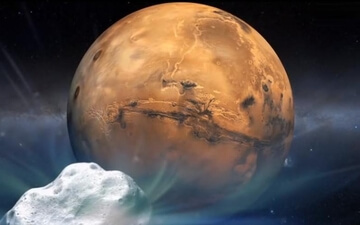NASA's fleet of spacecraft orbiting Mars, Earth and the Sun as well as ground-based telescopes will be front and center to photograph and study a once-in-a-lifetime event - the passage of a fresh comet arriving for the first time from the Oort cloud near Mars
Update to the article posted on October 12, 2014
see also "A ball of light in the sky of Mars"

NASA's fleet of spacecraft orbiting Mars, Earth and the Sun as well as ground-based telescopes will be front and center to photograph and study a once-in-a-lifetime event - the passage of a comet next Sunday, October 19.
Comet C/2013 A1, also known as Siding Spring, will pass about 140 kilometers from the face of the planet, less than the distance between the Earth and the Moon and less than a tenth of the distance that a comet has approached the Earth so far.
The nucleus of the Siding Spring comet will reach the closest point to Mars at 14:27 EST, 21:27 Israel time at a speed of about 56 kilometers per second. This proximity will create an unprecedented opportunity for researchers to gather data on both the comet and its impact on the Martian atmosphere.
"This is a cosmic science gift that may continue to provide interesting things, and the agency's fleet of scientific instruments will be on full alert." Says John Grunsfeld, astronaut and assistant director of the Science Missions Department at NASA Headquarters in Washington. "This particular comet has never before entered the inner solar system so it will provide us with a fresh source of clues to the early days of the solar system."
Siding Spring comes from the Oort Cloud, a sphere-like region that surrounds the Sun and fills the distance between 5,000 and 100,000 AU. This is a huge swarm of icy objects that are believed to be the remnants of the material created from the formation of the solar system."
Siding Spring will be the first comet from the Oort cloud to be studied closely by spacecraft, giving engineers a valuable opportunity to learn more about the materials it is made of, including water and carbon compounds, as they were during the formation of the solar system 4.6 billion years ago.
Some of the best scientific images and data will come from the assets orbiting Mars and the vehicles on its surface. In preparation for the comet's passage, NASA maneuvered the Mared Odyssey spacecraft, MRO, and the new addition to the Madimai fleet - Mayvan so that the risk of being hit by dust particles coming from the comet is reduced.
The most dangerous period for spacecraft orbiting Mars will begin about 90 minutes after the approach of the comet's nucleus and will last about twenty minutes, when Mars will approach the center of the spreading stream of dust that will fly from the comet's nucleus.
"The risk is not in the collision with the nucleus of the comet itself, but in the trail of particles that will come from it. Considering the constraint provided by the observations from Earth, the computer models made by NASA personnel indicate that the risk is not as great as they initially thought. Mars will be near the edge of the debris cloud, so spacecraft may absorb some particles, or even none." says Rick Zork, chief scientist for Mars missions at the Jet Propulsion Laboratory (JPL) in Pasadena, California.
The atmosphere of Mars, although it is much thinner than that of the Earth, will protect the robotic vehicles Opportunity and Curiosity from the dust of the comet if any of its particles reach the surface. Both vehicles are planned to observe the comet.
NASA's orbiters in orbit above Mars will collect data before, during and after the approach, about the size, rotation and activity of the comet's nucleus, the variation and gas composition of the halo around the nucleus, as well as the size and distribution of the dust particles in the comet's tail.
Observations of the Martian atmosphere are expected to examine meteor trails, changes in the distribution of neutral and charged particles, and the comet's effect on the temperature of the air and clouds. The Maven spacecraft will have a good opportunity to study the comet, to what extent its thin atmosphere - or halo, interacts with the upper atmosphere of Mars.
Ground telescopes and space telescopes orbiting the Earth, including the Hubble Space Telescope will be positioned to observe the unique celestial object. Kepler, Swift, Spitzer Chandra and the Infrared Observatory Telescope on Mauna Kea, Hawaii, will also monitor the event.
NASA's asteroid hunter Near-Earth Object Wide-field Infrared Survey Explorer (NEOWISE), photographed and will continue to photograph the comet as part of its ongoing operation. The spacecraft studying the Sun (a pair of Stereo spacecraft and the old Soho spacecraft) will also photograph the comet. In addition, NASA will launch a hot air balloon (BOPPS). A suborbital telescope has already provided observations of the comet as part of preparations for its approach to Mars.
NASA promises to continue to update and send images in real time.

One response
I think there was a mistake in the definition of an Oort cloud: it is not "a sphere-like area surrounding the Earth" but, "a sphere-like area surrounding the solar system"